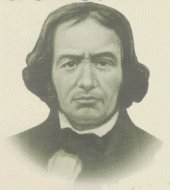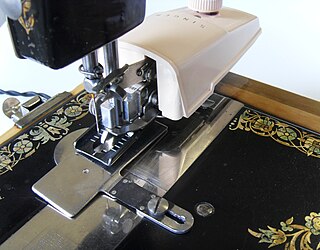
Snowboards are boards where both feet are placed, and most times secured, to the same board, which are wider than skis, with the ability to glide on snow. Snowboards widths are between 6 and 12 inches or 15 to 30 centimeters. Snowboards are differentiated from monoskis by the stance of the user. In monoskiing, the user stands with feet inline with direction of travel, whereas in snowboarding, users stand with feet transverse to the longitude of the board. Users of such equipment may be referred to as snowboarders. Commercial snowboards generally require extra equipment such as bindings and special boots which help secure both feet of a snowboarder, who generally rides in an upright position. These types of boards are commonly used by people at ski hills or resorts for leisure, entertainment, and competitive purposes in the activity called snowboarding.

A sewing machine is a machine used to sew fabric and materials together with thread. Sewing machines were invented during the first Industrial Revolution to decrease the amount of manual sewing work performed in clothing companies. Since the invention of the first sewing machine, generally considered to have been the work of Elias Howe and Englishman Thomas Saint in 1790, the sewing machine has greatly improved the efficiency and productivity of the clothing industry.

A lockstitch is the most common mechanical stitch made by a sewing machine. The term "single needle stitching", often found on dress shirt labels, refers to lockstitch.

A blister is a small pocket of body fluid within the upper layers of the skin, usually caused by forceful rubbing (friction), burning, freezing, chemical exposure or infection. Most blisters are filled with a clear fluid, either serum or plasma. However, blisters can be filled with blood or with pus.

The tibia, also known as the shinbone or shankbone, is the larger, stronger, and anterior (frontal) of the two bones in the leg below the knee in vertebrates, and it connects the knee with the ankle bones. The tibia is found on the medial side of the leg next to the fibula and closer to the median plane or centre-line. The tibia is connected to the fibula by the interosseous membrane of the leg, forming a type of fibrous joint called a syndesmosis with very little movement. The tibia is named for the flute tibia. It is the second largest bone in the human body next to the femur. The leg bones are the strongest long bones as they support the rest of the body.

Chain stitch is a sewing and embroidery technique in which a series of looped stitches form a chain-like pattern. Chain stitch is an ancient craft – examples of surviving Chinese chain stitch embroidery worked in silk thread have been dated to the Warring States period. Handmade chain stitch embroidery does not require that the needle pass through more than one layer of fabric. For this reason the stitch is an effective surface embellishment near seams on finished fabric. Because chain stitches can form flowing, curved lines, they are used in many surface embroidery styles that mimic "drawing" in thread.

Adhesion is the tendency of dissimilar particles or surfaces to cling to one another.

An overlock is a kind of stitch that sews over the edge of one or two pieces of cloth for edging, hemming, or seaming. Usually an overlock sewing machine will cut the edges of the cloth as they are fed through, though some are made without cutters. The inclusion of automated cutters allows overlock machines to create finished seams easily and quickly. An overlock sewing machine differs from a lockstitch sewing machine in that it uses loopers fed by multiple thread cones rather than a bobbin. Loopers serve to create thread loops that pass from the needle thread to the edges of the fabric so that the edges of the fabric are contained within the seam.

Barthélemy Thimonnier was a French inventor, who is attributed with the invention of the first sewing machine that replicated sewing by hand. He was born in L'Arbresle, in Rhône in France.

Feed dogs are the critical component of a "drop feed" sewing machine. A set of feed dogs typically resembles two or three short, thin metal bars, crosscut with diagonal teeth, which move back and forth in slots in a sewing machine's needle plate. Their purpose is to pull ("feed") the fabric through the machine, in discrete steps, in-between stitches.
The Ameli is a 5.56mm light machine gun designed for the Spanish Army by the nationally owned and operated Centro de Estudios Técnicos de Materiales Especiales (CETME) small arms research institute.

Longarm quilting is the process by which a longarm sewing machine is used to sew together a quilt top, quilt batting and quilt backing into a finished quilt. The longarm sewing machine frame typically ranges from 10 feet to 14 feet in length. A complete longarming system typically consists of an industrial length sewing machine head a 10 to 14-foot frame, a table with a layer of plastic under which is placed a pantograph, and several rollers on which the fabric layers and batting are attached.

Allen Benjamin Wilson (1823–1888) was an American inventor famous for designing, building and patenting some of the first successful sewing machines. He invented both the vibrating and the rotating shuttle designs which, in turns, dominated all home lockstitch sewing machines. With various partners in the 19th century he manufactured reliable sewing machines using the latter shuttle type.

Machine quilting is quilting made using a sewing machine to stitch in rows or patterns using select techniques to stitch through layers of fabric and batting in the manner of old-style hand-quilting. Some machines even replicate hand stitching, for example Sashiko or running stitch quilting.
The Singer Model 27 and later model 127 were a series of lockstitch sewing machines produced by the Singer Manufacturing Company from the 1880s to the 1960s.. They were Singer's first sewing machines to make use of "vibrating shuttle" technology. Millions were produced. They are all steel and cast iron, and were built before the advent of planned obsolescence, and so they were designed to be repaired rather than replaced. Consequently many remain today, some in collections and others still in service. In company literature they were called "the woman's faithful friend the world over".
A zigzag stitch is variant geometry of the lockstitch. It is a back-and-forth stitch used where a straight stitch will not suffice, such as in reinforcing buttonholes, in stitching stretchable fabrics, and in temporarily joining two work pieces edge-to-edge.

A buttonholer is an attachment for a sewing machine which automates the side-to-side and forwards-and-backwards motions involved in sewing a buttonhole.
The Davis Sewing Machine Company began in 1868 in Watertown, New York, and moved to Dayton, Ohio, around 1890.

A presser foot is an attachment used with sewing machines to hold fabric flat as it is fed through the machine and stitched. Sewing machines have feed dogs in the bed of the machine to provide traction and move the fabric as it is fed through the machine, while the sewer provides extra support for the fabric by guiding it with one hand. A presser foot keeps the fabric flat so that it does not rise and fall with the needle and pucker as it is stitched. When especially thick workpieces are to be sewn, such as quilts, a specialized attachment called a walking foot is often used rather than a presser foot.
Mary P. Carpenter or Mary P.C. Cooper was an American inventor from Buffalo, New York.
















